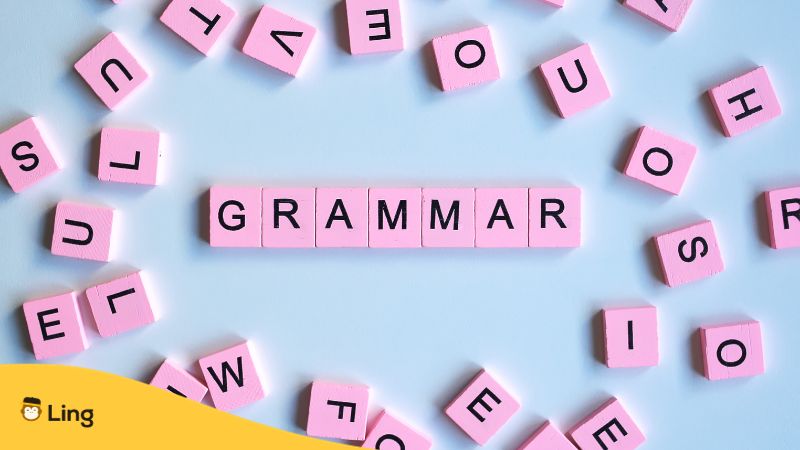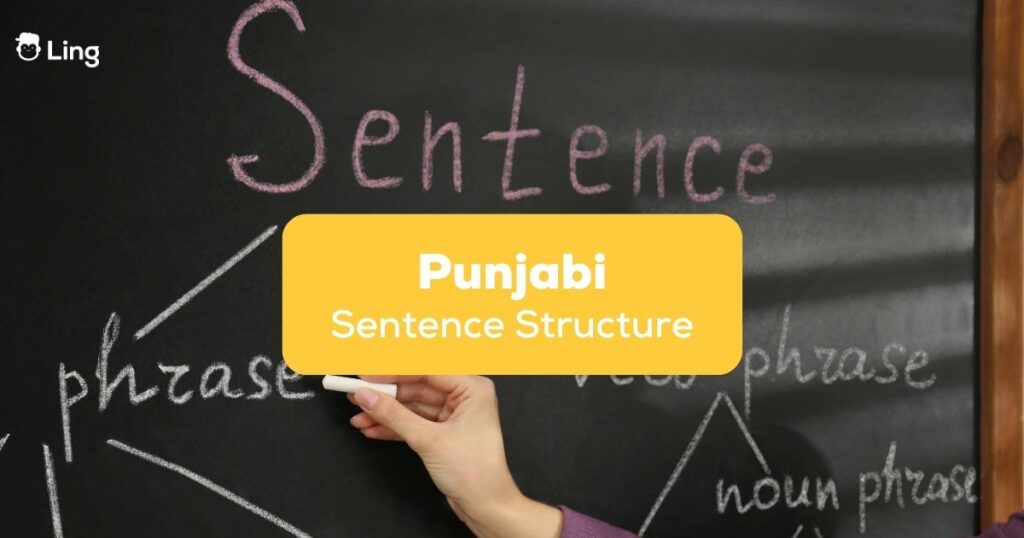Planning to learn the Punjabi language but do not know where to start? Memorizing words can only take you so far but learning Punjabi sentence structure can definitely boost your chances of getting understood by the locals.
If you are up for that, then you’ve come to the right place as this post will focus on how we can start learning the basics of a grammatically correct Punjabi sentence. Read on below to find out more!
Simple Punjabi Sentence Structure
There are tree key components that make up a basic and simple sentence:
- Subject (noun or pronoun)
- Object (noun, pronoun, or adjective)
- Verb
Consider the following examples to understand the concept of SOV:
Typical word order in English: (Subject) We, (Verb) are, (Object) kids.
However, Punjabi typically follows a Subject-Object-Verb (SOV) word order, distinct from the English SVO pattern. For instance, “I eat an apple” in Punjabi is structured as “I an apple eat.” This syntax shapes how sentences are formed, making the verb’s placement at the end a unique feature of Punjabi grammar.
Standard word order in Punjabi: (Subject) Asī or ਅਸੀਂ, (Object) Bacē or ਬੱਚੇ, (Verb) hāṁ or ਹਾਂ.

Punjabi Sentence Structure Based On Tenses
No matter what language you speak, we can all agree that a dramatically correct sentence can help you prevent communication breakdown and improve your chances of starting a good relationship with the locals. So if you have a colleague who speaks this language, then be sure to review the common tenses in Punjabi.
Present Tense
A present tense expresses a currently occurring or frequently occurring action or a state. As we know, this type of sentence shows progressions includes the continuous happening tense. To make the sentence structure of preset tense, you have to write simple Punjabi sentences like the examples below.
Let’s look at the simple sentence “I play cricket.” In Punjabi, it is said as: Maiṁ krikaṭa khēḍadā hāṁ (ਮੈਂ ਕ੍ਰਿਕਟ ਖੇਡਦਾ ਹਾਂ) or “I cricket play.”
This present sentence is a combination of the imperfective participle: root (Khēḍaṇa or ਖੇਡਣ)+ dā (ਦਾ for singular-masculine)/ dī (ਦੀ for singular-feminine)/ de (ਦੇ for plural-masculine)/ dīāṅ (ਦੀਆਂ for plural-feminine) with the conjugated form of hoṇā (ਹੋਣਾ) or “to be”.
You can check out these similar examples:
| English | Punjabi | Pronunciation |
|---|---|---|
| I play | ਮੈਂ ਖੇਡਦਾ ਹਾਂ (m) ਮੈਂ ਖੇਡਦੀ ਹਾਂ (f) | Maiṁ khēḍadā hāṁ (m) Maiṁ khēḍadī hāṁ (f) |
| He plays | ਉਹ ਖੇਡਦਾ ਹੈ | Uha khēḍadā hai |
| She plays | ਉਹ ਖੇਡਦੀ ਹੈ | Uha khēḍadī hai |
| We play | ਅਸੀਂ ਖੇਡਦੇ ਹਾਂ | Asīṁ khēḍadē hāṁ |
| They (girls) play | ਉਹ ਖੇਡਦੀਆਂ ਹਨ | Uha khēḍadī’āṁ hana |
| They (boys) play | ਉਹ ਖੇਡਦੇ ਹਨ | Uha khēḍadē hana |
Past Tense
In the Past tense, we talk about the action that has already taken place by using basic Punjabi words and phrases. So, by changing the form of the verb in the simple present tense, you can get the simple past tense. For example:
| English | Punjabi | Pronunciation |
|---|---|---|
| I played | ਮੈਂ ਖੇਡਿਆ (m) ਮੈਂ ਖੇਡੀ (f) | Maiṁ khēḍi’ā (m) Maiṁ khēḍī (f) |
| He played | ਉਸਨੇ ਖੇਡਿਆ | Usanē khēḍi’ā |
| She played | ਉਸਨੇ ਖੇਡਿਆ | Usanē khēḍi’ā |
| We played | ਅਸੀਂ ਖੇਡੇ | Asīṁ khēḍē |
| They (girls) played | ਉਹ ਖੇਡੀਆਂ | Uha khēḍī’āṁ |
| They (boys) played | ਉਹ ਖੇਡੇ | Uha khēḍē |
Future Tense
Simple future tense discusses the situation which is going to happen. We will write the simple future tenses as:
| English | Punjabi | Pronunciation |
|---|---|---|
| I will play | ਮੈਂ ਖੇਡਾਂਗਾ (m) ਮੈਂ ਖੇਡਾਂਗੀ (f) | Maiṁ khēḍāṅgā (m) Maiṁ khēḍāṅgī (f) |
| He will play | ਉਹ ਖੇਡੇਗਾ | Uha khēḍēgā |
| She will play | ਉਹ ਖੇਡੇਗੀ | Uha khēḍēgī |
| We will play | ਅਸੀਂ ਖੇਡਾਂਗੇ | Asīṁ khēḍāṅgē |
| They (girls) will play | ਉਹ ਖੇਡਣਗੀਆਂ | Uha khēḍaṇagī’āṁ |
| They (boys) will play | ਉਹ ਖੇਡਣਗੇ | Uha khēḍaṇagē |
Other Grammatical Concepts In Punjabi
Words alone do not form a language. A sentence can have several different parts, such as a noun, verb, auxiliary verb, and adjective. Read on below to find out more about these.
Nouns are those English words that refer to the name, place, or thing like the following words: Love (pi’āra-ਪਿਆਰ), phone (fōna-ਫ਼ੋਨ), apple (sēba-ਸੇਬ), dog (kutā-ਕੁੱਤਾ). On the other hand, we should also not forget about adjectives that deal with the description of a noun. For example, beautiful girl (sōhaṇī kuṛī-ਸੋਹਣੀ ਕੁੜੀ), nice watch (vadhī’ā ghaṛī-ਵਧੀਆ ਘੜੀ), green trees (harē rukha-ਹਰੇ ਰੁੱਖ).
The Punjabi Language
The need to learn a second language always comes out when you have to travel or handle an international business meeting. Fortunately, there are tons of available languages out there that you can focus on, and choosing the right one depends on certain factors: your likes, motivations, and professional goals. If you are on the lookout to master one which is totally unique yet very useful, then the Punjabi language is what you should try out.
The origin and literal meanings of Punjabi are broad and interesting. Basically, this language evolved from Prakrit and afterward Apabhramsa (Sanskrit) languages. And as far as the origin is concerned, Punjabi is the native language of Punjab in India and Pakistan. It is also the 11th most generally spoken language in India, while it is the second highly preferred language in Pakistan. With such a huge number of speakers, having mastery of this can seriously help you develop a competitive advantage.

Wrapping Up
As we reach this part of the post, we hope that you were able to master the basics of Punjabi sentences. If there are certain points by which you need clarifications, feel free to send a comment down below and we’d love to get back to you and help out.
Now if you are more interested in starting to learn Punjabi and speak it like a real pro, we’ve got a language learning platform that will surely excite you – the Ling app! Not only do apps help keep the cost down as compared to buying lots of expensive language books, but they are also great at motivating and reminding you to start learning every single day.
With the Ling app, you can learn the entire course related to the Punjabi Language-from grammatical points, words, phrases, to cultural meanings, this application got your back! Instead of just bombarding you with walls of texts, it has fun mini-games, AI-based chatbots, and enjoyable quizzes that do not let the learner get bored of learning.
You can download the app on the App Store or Play Store for a quick and free trial. So, what are you waiting for? Do not miss out on the chance to start learning a new foreign language the right way with Ling app.
Updated by Punya





















One Response
Thank you for an opportunity to learn the language for us to communicate well with our friends